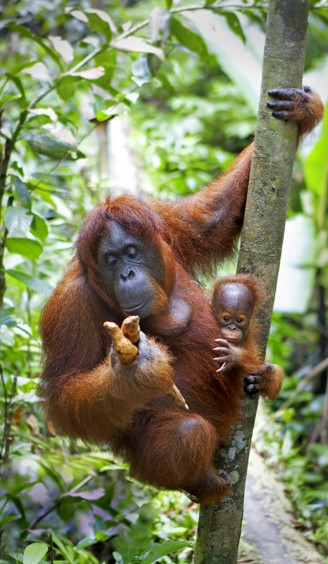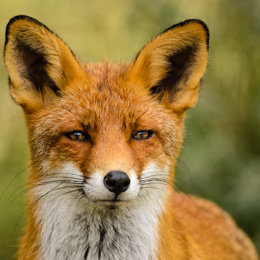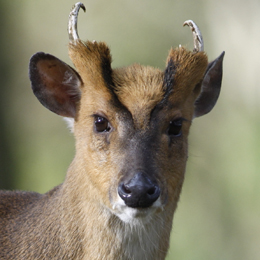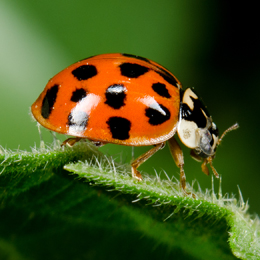Description
These beautiful creatures, along with Sumatran orangutans, belong to the only genus of the great apes found in Asia. Bornean orangutans are the biggest tree-dwelling mammals. They are about 1.4 m (4.5 ft) long, and their average weight is about 80 kg (75 lb).
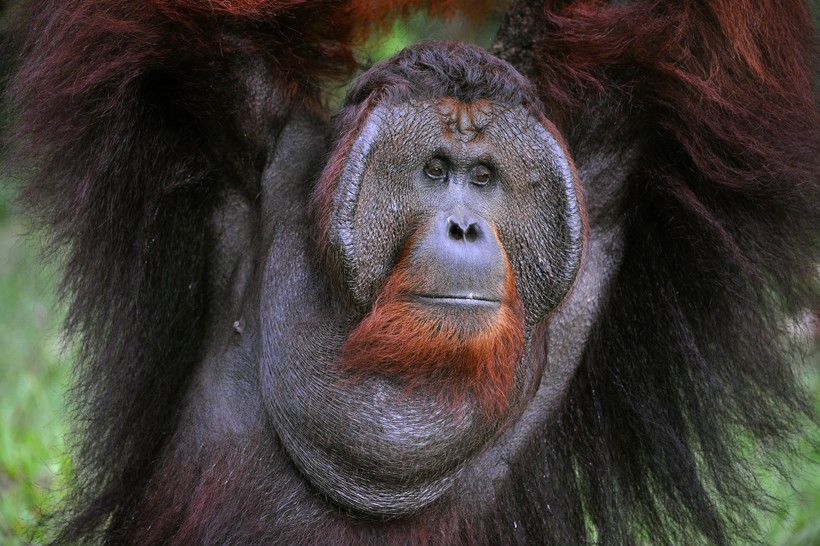
Flanged bornean orangutan male
?
Image credits: Sergey Uryadnikov/Shutterstock
The main difference between the male and female Bornean orangutan is the size. Males are larger than females. The average length of males is between 1.2 and 1.4 m (3.9 and 4.6 ft) while that of females is between 1 and 1.2 m (3.3 and 3.9 ft). Males weigh between 50 and 100 kg (110 and 220 lb), whereas females weigh between 30 and 50 kg (66 and 110 lb).
Another interesting difference between the sexes is that there are two types of adult males: flanged and unflanged. As the name suggests, flanged males have cheek pads that resemble fleshy, protruding flanges on both the sides of their faces. The flanged males are larger than the unflanged ones. The long vocalizations of the flanged males also set them apart from an unflanged male Bornean orangutan. The long vocalizations help males to attract females. Females are not divided into flanged or unflanged ones.
Adult males are typically solitary creatures. This behavior is not found among adult females. For short periods of time, females associate themselves with other females. Infant and juvenile offspring live with their mother. The parental care of Bornean orangutans is offered by the females while the males' role is only to impregnate the females and protect them from unflanged males.
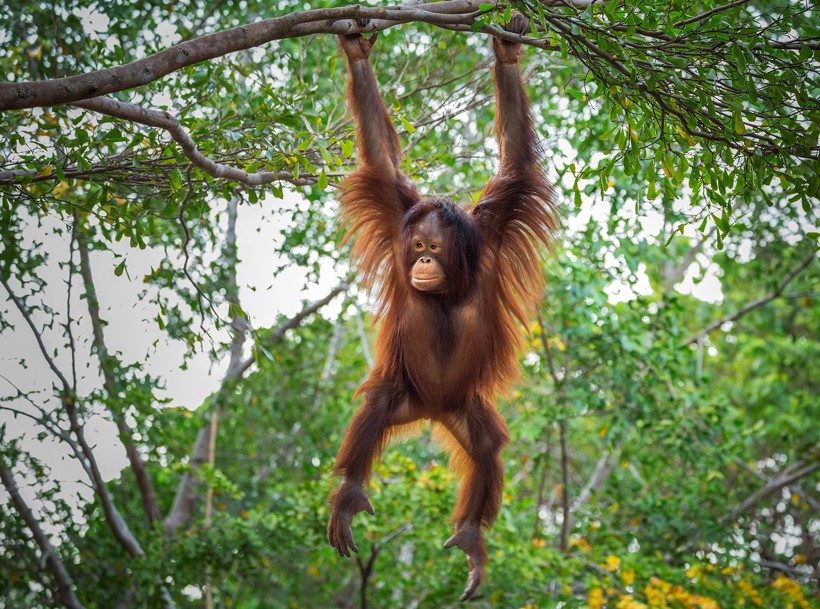
Young bornean orangutan hanging in a tree
?
Image credits: jeep2499/Shutterstock
As they do not have any known predators other than human beings, Bornean orangutans can live up to an age of 30 to 40 years in the wild. They reach double this lifespan in captivity when the conditions are favorable. Like other apes, Bornean orangutans have binocular vision for depth perception, meaning that both eyes are focused on the same object. They depend more on their vision rather than the smell as they have a reduced olfactory sense.
Subspecies
The primates of Borneo have three subspecies.- Northwest Bornean Orangutans (P. p. pygmaeus)
This subspecies is found in northwestern Kalimantan in Indonesia and Sarawak in Malaysia. The majority of the population is found in four conservation sites: Betung Kerihun National Park, Batang Ai National Park, Danau Sentarum National Park and Lanjak Entimau Wildlife Sanctuary. Although all the subspecies of Bornean orangutans are endangered, Northwest Bornean orangutans are the most vulnerable one. Only around 4,500 individuals are remaining in the habitat of about 7,500 square km. - Central Bornean Orangutans (P. p. wurmbii)
The largest of the Bornean orangutans, the Central Bornean orangutans are natives to Central Kalimantan and Southwestern Kalimantan in Indonesia. According to some studies, Central Bornean orangutans are closer to the Sumatran orangutans than to the Bornean orangutans. This is the most populous subspecies of the Bornean orangutans with more than 34,000 individuals in the wild. - Northeast Bornean Orangutans (P. p. morio).
The smallest of the three subspecies of Bornean orangutans, the Northeast Bornean orangutan is found in Sabah in Malaysia and East Kalimantan in Indonesia. Identification of this subspecies was at a later time as the other 2 subspecies.
It is difficult to differentiate between the three subspecies without DNA analysis.
This subspecies is found in northwestern Kalimantan in Indonesia and Sarawak in Malaysia. The majority of the population is found in four conservation sites: Betung Kerihun National Park, Batang Ai National Park, Danau Sentarum National Park and Lanjak Entimau Wildlife Sanctuary. Although all the subspecies of Bornean orangutans are endangered, Northwest Bornean orangutans are the most vulnerable one. Only around 4,500 individuals are remaining in the habitat of about 7,500 square km.
The largest of the Bornean orangutans, the Central Bornean orangutans are natives to Central Kalimantan and Southwestern Kalimantan in Indonesia. According to some studies, Central Bornean orangutans are closer to the Sumatran orangutans than to the Bornean orangutans. This is the most populous subspecies of the Bornean orangutans with more than 34,000 individuals in the wild.
The smallest of the three subspecies of Bornean orangutans, the Northeast Bornean orangutan is found in Sabah in Malaysia and East Kalimantan in Indonesia. Identification of this subspecies was at a later time as the other 2 subspecies.
Anatomy and Characteristics
These primates have shaggy, coarse coats that are reddish-brown. The red-orange patchy coats on the gray or black skin are distinctive for these great apes. They have wide faces without hair growth, so a naked skin is displayed.
As they are the largest arboreal mammals, they have multiple adaptations to live in the trees. The opposable thumbs and large toes are fashioned to help the mammals get a good grip. They have long, powerful arms that can grow to a length of about 1.5 m. The arms are about 3% longer than their legs.
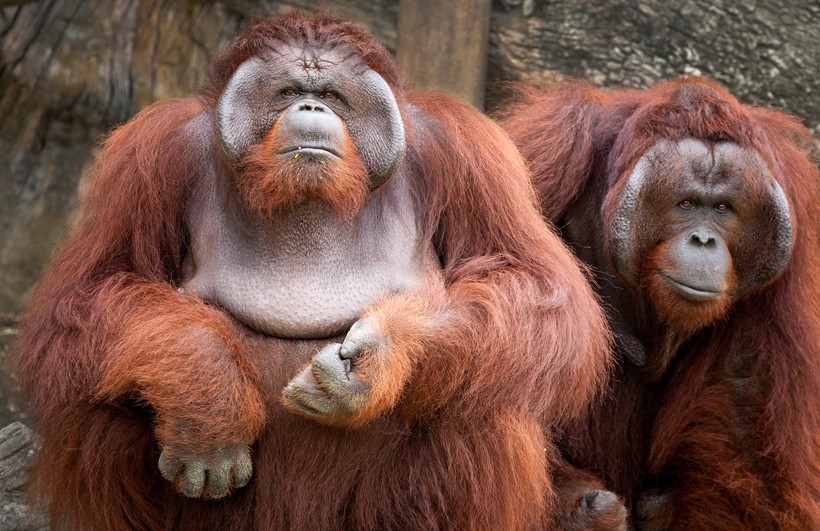
Large flanged males with the typical reddish-brown coat
?
Image credits: apple2499/Shutterstock
Bornean orangutans are highly sexually dimorphic. Males are considerably bigger in size than females. On attaining sexual maturity, "flanges" are developed on both sides of the face for male Bornean orangutans. These flanges are cheek pads that have subcutaneous fat connected by tissues. Throat sacs are also developed in adult males. Throat sacs are inflated to assist males in producing deep, resonating calls during mating periods.
"The omnivorous Bornean orangutan possesses large flat teeth to grind hard seeds and barks of trees"
The dexterous hands and feet of males and females are specially designed to open, peel, and eat fruits. They have large flat teeth to grind the hard seeds as well as barks of trees.
Bornean vs Sumatran orangutan
Bornean orangutans (Pongo pygmaeus) and Sumatran orangutans (Pongo abelii) are the two species of great apes exclusive to Asia. They belong both to the same genus - Pongo, but the similarities end there.
As the name suggests, Bornean orangutans are natives of the island of Borneo whereas Sumatran orangutans are found on the island of Sumatra in Indonesia. Pongo pygmaeus are more common with around 45,000 individuals in the wild as compared to about 7,500 Pongo abelii left.
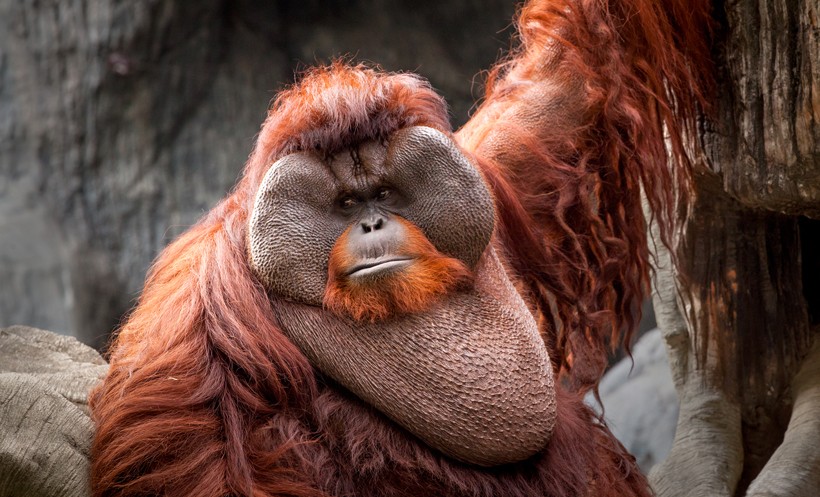
The large cheek pad of a male bornean orangutan
?
Image credits: apple2499/Shutterstock
Both differ in their appearances as well. Sumatran orangutans have a longer beard, a smaller stature, longer elongated faces and lighter hair than Bornean orangutans. The natives of Sumatra have also smaller flanges, that are covered with white hair, than their Bornean counterparts. The cheek pads of male Bornean orangutans are extremely large and have small hairs that resemble human beards.
Sumatran orangutans are also more social and enjoy stronger social bonds than the Bornean orangutans. Sumatran orangutans are said to have the longest interval birth rates among all primates. Exclusively arboreal, Sumatran orangutans rarely travel on the ground. This is not so extreme among Bornean orangutans. The male Bornean orangutans are often seen to descend to ground level.
Regardless the differences between Bornean and Sumatran orangutans, both are highly endangered species.
Habitat
Orangutans are the only species of great apes that are found outside Africa. Bornean orangutans mainly inhabit hilly and lowland tropical rain forests. They prefer elevations of around 1,500 m above sea level. These active primates live on top of the rainforest canopies. To support this, they are equipped with strong long arms, dexterous hand-like feet, and flexible hips. However, males venture to the ground occasionally. They travel long distances in search of fruit-bearing trees.
Bornean orangutans are natives of the island of Borneo, south-east Asia. They can be found in Malaysia and Indonesia. Habitat loss is one of the major reasons why this species is fighting for its survival.
Diet
It can be said that Bornean orangutans consume large amounts of food and their diet typically consists of 400 different types of food. Although primary herbivores, they occasionally use omnivorous diets. They enjoy fruits (such as durians and figs), flowers, honey, leaves, tree barks, seeds, and vines. But rarely they also consume small vertebrates such as slow lories, insects, and birds' eggs.
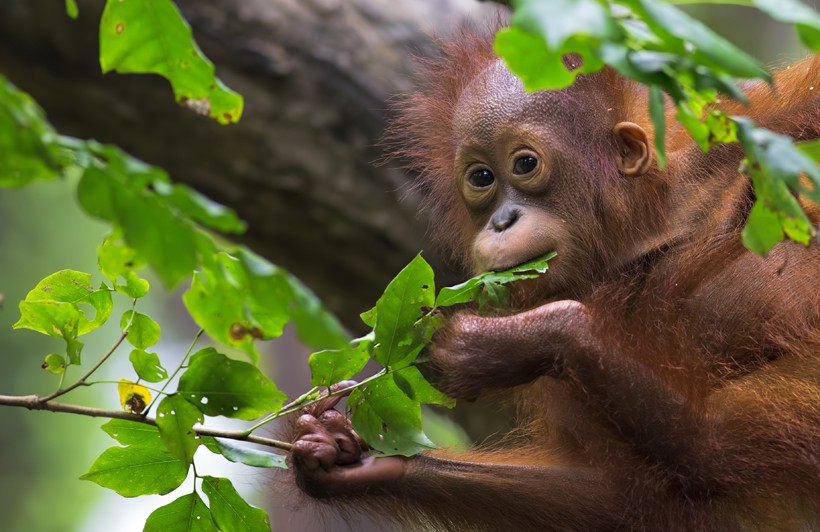
Bornean orangutans are primary herbivores
?
Image credits: Kjersti Joergensen/Shutterstock
The primates travel long distances to find trees with fruits. Since they are highly intelligent creatures, Bornean orangutans are said to use tools to eat food. They wipe feces from their food using leaves and hold spiny durians with a pad of leaves. Leaves are also used to collect water for drinking. During dry seasons, the moisture from the tree hollows is soaked up using leaves.
Sometimes, these orangutans eat soil to fulfill their mineral needs. This is important to reduce the harmful effects of toxins and acids present in their vegetarian diets. There are no large natural predators known to threaten Bornean orangutans but face the biggest risk coming from humans.
Reproduction and Life Cycle
Male Bornean orangutans attain sexual maturity around the age of 15 years. Fully descended testicles that allow the males to reproduce are the first signs of sexual maturity among males. The cheek pads, throat sacs and long fur begin to develop between 15 and 20 years of age. These characteristics develop typically in the absence of resident males.
Flanged males (males with flanges) are extremely territorial. They establish a territory that includes multiple female territories. All the females within the male's territory copulate with the flanged male to produce offspring. Thus, they follow a polygynous mating system.
Unflanged males (males without flanges) and flanged males have different mating strategies. To attract estrus females, dominant flanged males use their long calls that can be heard up to a distance of 3 km. Unflanged males may wander for long distances in search for a female mating partner. Once the unflanged males find an estrus female, a forced copulation follows. Both strategies lead to successful copulation. However, females prefer flanged males above un-flanged ones and choose the former for protection against the latter.
Females experience their first ovulatory cycle between 6 and 11 years of age. This may happen at an earlier age for females with excess body fat. The female Bornean orangutan has an ovulatory cycle of around 22 to 30 days. They give birth to the first infant around the age of 14 or 15 years. Menopause has been observed around 48 years of age among female Bornean orangutans in captivity.
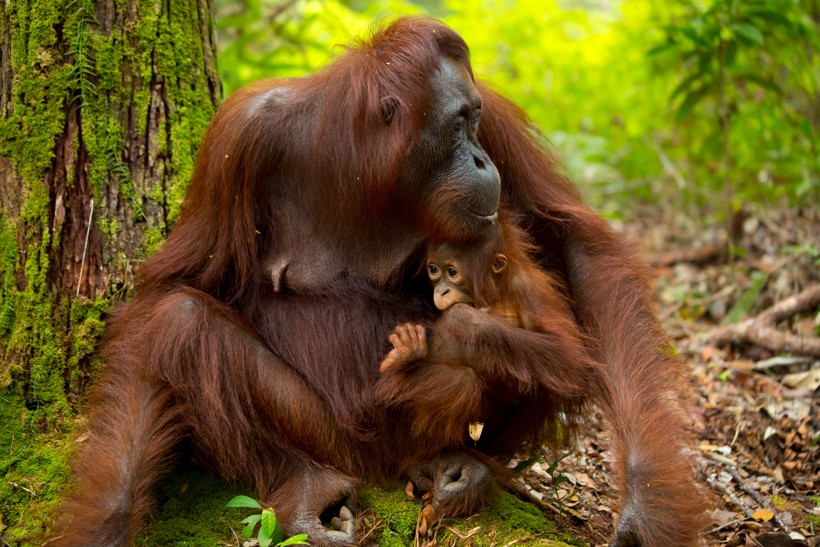
Mothers nurse the little ones for 3-5 years
?
Image credits: Kate Capture/Shutterstock
After a gestation period of about 9 months, females give birth to 1 infant, and rarely twins. During the first two to three years, mothers continuously carry their infants and take up the sole responsibility of providing the offspring with parental care. Mothers nurse the little ones for 3 to 5 years. Infants smile at their mother, throw tantrums and cry when hungry, like human babies. They are totally dependent on their mother and remain with them for about 10 years.
Young male offspring, despite being sexually mature, remains socially immature. They are forced to wander in the forest and avoid contact with mature flanged males. Once the young males become flanged males, they establish their own territories. Female offspring remains with the mother for an additional 3 years to learn important parenting skills. During this period, they observe how to take care of young orangutans to raise their own offsprings later on. Female offsprings separate from their mothers once they start displaying sexual behavior.
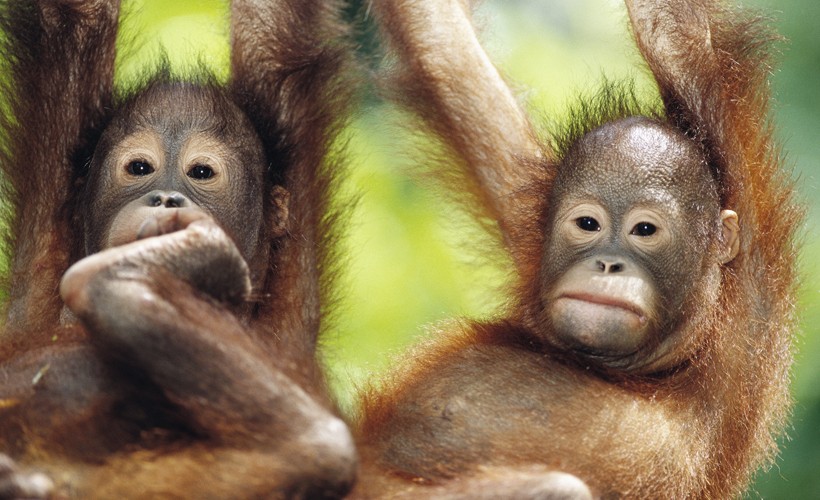
Two infants hanging in a tree
?
Image credits: BMJ/Shutterstock
Bornean orangutans do not have a fixed breeding season and breed around the year. However, they are one of the slowest breeding mammals. Their inter-birth interval is about 8 years. This slow rate of reproduction makes it difficult for the Bornean orangutan population to restore after habits loss, human encroachment or natural disasters. For pet trade, hundreds of infants are taken away from their mothers and these mothers are invariably killed.
Behavior, Communication and Intelligence
Unlike other great apes, Bornean orangutans are typically solitary creatures. Males visit females for mating purpose only. The only exception to this rule are the female Bornean orangutans and their offsprings who stay together. Occasionally social connections among Bornean orangutans have been observed, especially during the periods when grouped trees produce fruit simultaneously.
Predominantly arboreal, Bornean orangutans spend most of their time sitting and eating on trees. They occupy the canopy and construct nests of folded leafy branches to sleep at nights. Being diurnal, they are active during the days and sleep at nights.
Their daily movements frequently change based on the availability of food. Bornean orangutans follow different locomotion methods. Adult Bornean orangutans are too heavy to jump from branch to branch. They rely on brachiation (swinging from branch to branch). Also, as males are much heavier than females, they are more likely to travel on the ground. Unlike great apes, adults walk on their fists and not on their knuckles.
Since Bornean orangutans are not able to swim, they cannot cross rivers and other water bodies. This limits their range. Although Bornean orangutans travel only half a mile daily, they have wide home ranges that are shared by other Bornean orangutans. Males, having a particular territory, enjoy the mating rights with all the females in their territory. This territory is marked by loud, deep calls that echo in the forests.
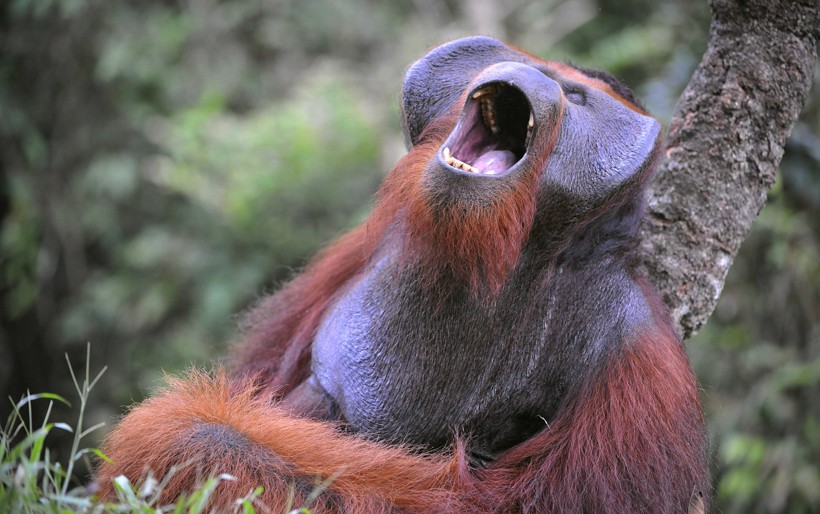
Flanged male yawn
?
Image credits: Sergey Uryadnikov/Shutterstock
There are only a few social vocalizations as Bornean orangutans are not such social creatures. One of the most dominant forms of communication is the loud call made by flanged males to attract sexually active females. Also, when they are scared, they funnel their lips and scream. Fast calls are made at the end of conflicts between males. They also make short sounds by smacking lips when in small social groups.
Bornean orangutans are highly intelligent primates. This is evident with their usage of tools. It is believed that these mammals use spear-like tools to catch fish, sticks to scratch backs, leafy branches as umbrellas, and tree trunks as missiles. Bornean orangutans are also believed to show signs of a culture.
Population and Conservation Status
There are about 45,000 Bornean orangutans in the wild. They are listed as endangered species as their population has been declining. As easy targets for hunters, due to their large size and slow pace, they are captured for illegal pet trade. Another major threat to Bornean orangutans is the loss of habitat due to illegal logging, agriculture and palm oil plantations. Since their birth rate is extremely low, it takes a long time to restore their population.
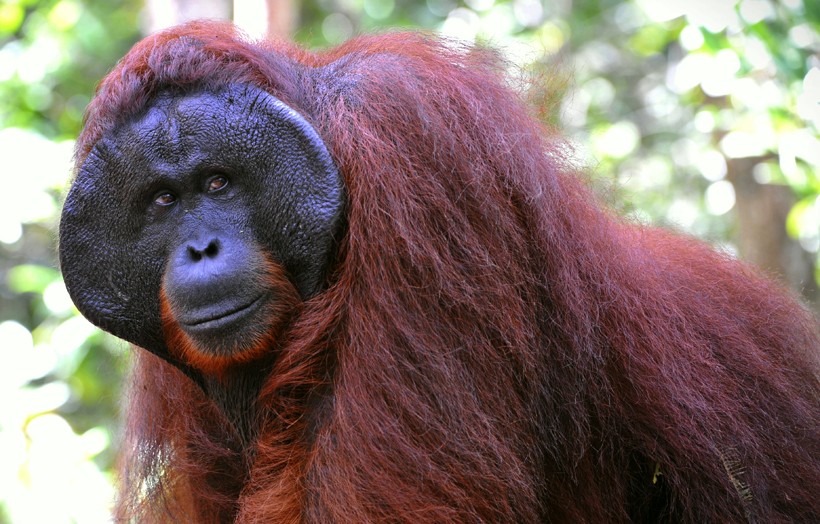
The Bornean orangutan is listed as endangered species as their population has been declining.
?
Image credits: Sergey Uryadnikov/Shutterstock
They play an important role in seed dispersal as 60% of their diet consists of fruits. That's why they are considered as the gardeners of the forests and why it is so important and vital to protect these wonderful apes. Conservation efforts have been taken by the Indonesian and Malaysian governments. Habitat destruction and illegal pet trade should be stopped immediately to save these wonderful creatures.
Evolutionary History
Evidence suggest that orangutans might have walked on earth 2 million years ago. Until about 25 million years ago, the old world monkeys and apes were categorized under one group. In time, they evolved into 2 separate categories. They belong to the great ape family that might have evolved from the group of smaller apes.
Analysis of fossils of Sivapithecus species found in Turkey, Pakistan and China indicates that they had a bone structure that supported movement on the ground as well as in trees. Their diet consisted of grasses and seeds. The Sivapithecus is believed to be the direct ancestor of the orangutans living today. Bornean orangutans separated from Sumatran orangutans about 400,000 years ago.
Funfacts
- Bornean orangutans are considered as "umbrella species" which means that they are critical for the development of the flora and fauna in their area.
- These large arboreal mammals help in spreading the seeds of trees.
- They use leafy branches to keep away mosquitoes that bother them.
